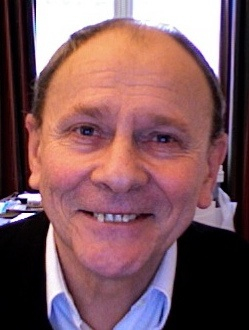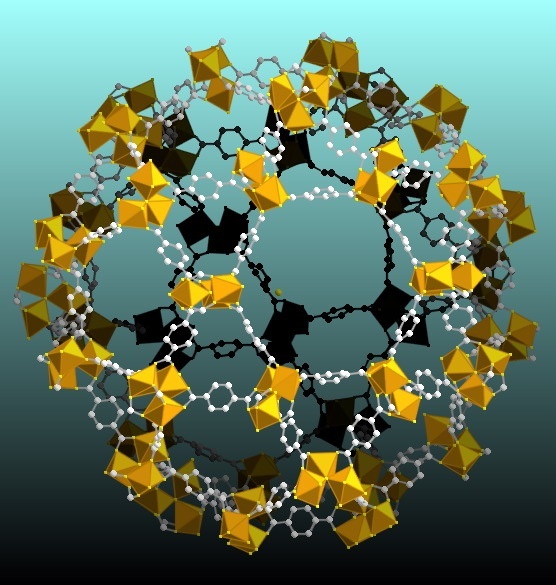From Interesting to Useful: the Contribution of Porous Solids to the Society
Gérard Férey
Abstract:
The story of porous solids begins in 1756 in Sweden, but their tremendous development during the last twenty years make them now strategic materials.
The example of hybrid porous solids – which result from the three-dimensional association by strong bonds of inorganic and organic moieties – illustrates what the integrated approach of chemists must be, from pure academic research to industrial production, for providing solutions to current societal problems in the domains of energy, energy savings, sustainable development and health.
The mastery of ‘tailor-made’ syntheses implies the knowledge of the mechanisms of formation of these solids. Once elucidated, it allows, playing on their different characteristics (framework, pores and specific surface area), to introduce new properties, to tune the size of the pores, and even predict the structure of new solids for generating the applications and the industrial development in various domains.
For example, hybrid porous solids are excellent materials for hydrogen storage at 77K, and for greenhouse gases at room temperature. Their separating power for gas mixtures operates with low energy consumption. Beside, they are excellent catalysts and, recently, these non-toxic solids appear to be the best nanovectors for the storage and long-term delivery of anti-tumoral and anti-retroviral drugs. Their easy production at large scale leads for some of them to an industrial development.
Some references:
1. G. Férey et al., Science 2005, 309, 2040.
2. G. Férey, Chem. Soc. Rev. 2008, 37, 191.
3. C. Serre, G. Férey, Adv. Mater. 2007, 19, 2246.
4. P. Llewellyn et al., Langmuir 2008, 24, 7245.
5. G. Férey et al., Nature Mater. 2010, 9, 172.
Gérard Férey
Abstract:
The story of porous solids begins in 1756 in Sweden, but their tremendous development during the last twenty years make them now strategic materials.
The example of hybrid porous solids – which result from the three-dimensional association by strong bonds of inorganic and organic moieties – illustrates what the integrated approach of chemists must be, from pure academic research to industrial production, for providing solutions to current societal problems in the domains of energy, energy savings, sustainable development and health.
The mastery of ‘tailor-made’ syntheses implies the knowledge of the mechanisms of formation of these solids. Once elucidated, it allows, playing on their different characteristics (framework, pores and specific surface area), to introduce new properties, to tune the size of the pores, and even predict the structure of new solids for generating the applications and the industrial development in various domains.
For example, hybrid porous solids are excellent materials for hydrogen storage at 77K, and for greenhouse gases at room temperature. Their separating power for gas mixtures operates with low energy consumption. Beside, they are excellent catalysts and, recently, these non-toxic solids appear to be the best nanovectors for the storage and long-term delivery of anti-tumoral and anti-retroviral drugs. Their easy production at large scale leads for some of them to an industrial development.
Some references:
1. G. Férey et al., Science 2005, 309, 2040.
2. G. Férey, Chem. Soc. Rev. 2008, 37, 191.
3. C. Serre, G. Férey, Adv. Mater. 2007, 19, 2246.
4. P. Llewellyn et al., Langmuir 2008, 24, 7245.
5. G. Férey et al., Nature Mater. 2010, 9, 172.
Gérard Férey - Short Biography#
Gérard Férey created the Institut Lavoisier (CNRS 8180) of the university of Versailles in 1996 after being Professor at the University of Le Mans (1967-1995) and Deputy-Director of the Chemistry Department of CNRS (1988-1992). Previously devoted to the structural chemistry and magnetism of inorganic fluorides, his research concerns since 1992 the synthesis, the structure, the mechanisms of formation, the structural prediction and the applications of inorganic and hybrid porous solids. Produced at the industrial scale, some of his solids find applications in the domains of energy (hydrogen storage, conducting solids), sustainable development (capture of CO2) and health (storage and delivery of antitumoral and antiviral drugs). Author of more than 550 publications, 11 patents, he is known worldwide, with prestigious awards (USA, Japan, Germany, Spain, India). He received in 2010 the Gold Medal of CNRS, the highest distinction for a French scientist, all disciplines included.Professor at the Institut universitaire de France (1999-2009), Member of the French Academy of Sciences (2003-…) and of several foreign Academies, Knight of the Légion d’Honneur, he now belongs to the French Committee of Ethics.



